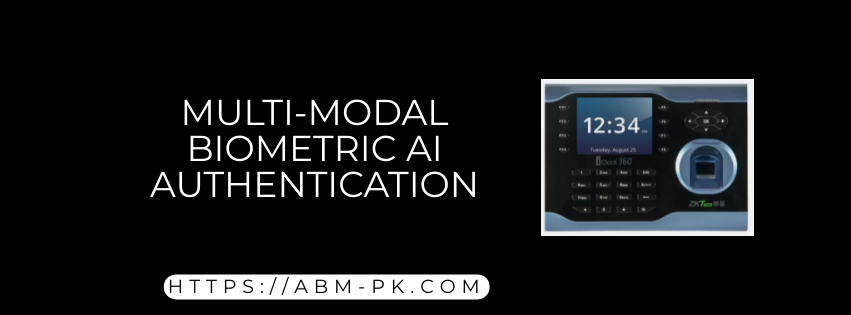Unlocking the digital world with something more unique than a password, something that’s literally a part of you. This is the world of multi modal biometric AI authentication. Instead of just your fingerprint or a face scan, this powerful technology uses a combination of two or more biometric traits to verify your identity. Think of it as a super-secure digital handshake, where your face, voice, and even the way you type all work together to say, “It’s really me.” This layered approach, powered by advanced AI, is the next frontier in keeping our digital lives safe and secure.

What is Multi-Modal Biometric AI Authentication?
So, what’s the big deal with multi-modal biometric AI authentication? It’s a security system that combines multiple biometric inputs to confirm your identity. ABM innovative FZE offer a simple fingerprint or facial recognition, a multi modal biometric AI authentication system doesn’t depend on just one thing. It could use your fingerprint and a voiceprint simultaneously. Or, it might check your face and your iris pattern. The system fuses the data from these different “modes” to create a more robust and reliable authentication profile. Artificial Intelligence is the brain of the security recognition operation, learning to recognize delicate patterns in these diverse database streams. This makes it much, much harder to trick the system. If a bad actor tries to use a photo to spoof your face, the multi-modal biometric AI authentication system will also be checking for “liveness” and other traits, like your voice, which a photo can’t replicate.
The Power of Fusion: How It Works
The magic of multi modal biometric AI authentication lies in its fusion capabilities. This isn’t just about running two separate checks; it’s about combining the results for a single, powerful decision. There are a few ways this can happen. One method is feature-level fusion. This is where the AI analyzes the raw data from each biometric input, like the ridges in a fingerprint and the unique features of a face, and combines them into one super-profile. Another, more common approach is score-level fusion. Here, each individual biometric check gets a “match score. The system then combines these scores using a smart algorithm. For instance, if your facial recognition score is a bit low because of bad lighting, a high voiceprint score could still give you the green light. Multi modal guarantees a unified user experience without negotiating biometric trait safekeeping. ABM biometric intelligent fusion is why multi-modal biometric AI authentication is so much more reliable than its single-modality cousins.

Why We Need Multi-Modal Biometric AI Authentication
We live in a world of constant threats to our digital identities. Single-factor authentication is a single point of failure. Even with single-modal biometrics, a dedicated hacker can find ways to trick the system. Think about it: A high-quality photo might fool a basic facial recognition system. Or a recording of your voice could get past a simple voiceprint check. But multi modal biometric AI authentication closes those doors. To hack a multi-modal biometric AI authentication system, you’d have to spoof two or more different biometric traits at the exact same time, which is a near-impossible feat. This is why industries handling sensitive data—like banks, government agencies, and airports—are rapidly adopting multi-modal biometric AI authentication. It’s the ultimate defense against sophisticated fraud and identity theft.

FAQs about Multi Modal Biometric AI Authentication
Q1: Is multi-modal biometric AI authentication expensive?
Yes, multi-modal biometric AI authentication systems can be more costly to implement than single-modal systems. The increased complexity means more sophisticated hardware and software are required. However, as the technology becomes more widespread, the cost is decreasing. The enhanced security and reduced risk of fraud often justify the initial investment.
Q2: What about privacy concerns with multi-modal biometric AI authentication?
Privacy is a critical consideration for multi-modal biometric AI authentication. The data collected is highly personal. Reputable systems use encryption and a process called “template generation.” Instead of storing your raw biometrics (like a photo or recording), the system stores a mathematical representation, or template, of your unique traits. ABM sensors template can’t be reverse produced to refabricate your original biometric fingerprint or facial recognition data in access control system.
Q3: What’s the future of multi-modal biometric AI authentication?
The future of multi-modal biometric AI authentication is incredibly exciting. We’re seeing new modalities being explored, like gait recognition (the way you walk) and even heartbeat patterns. AI will continue to make these systems more adaptive and seamless. Soon, your identity could be verified in the background as you walk into a building or log into an app, without you even having to think about it. This continuous and passive authentication is the next major step for multi-modal biometric AI authentication.

